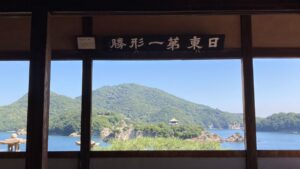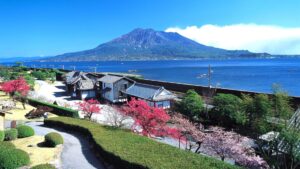Nagoya of Art and Culture, Tokugawa Yoshinao's Achievement
Within the Honmaru Palace of Nagoya Castle, esteemed artists of the Kano school, including Kano Tanyu (1602-1674, 狩野探幽), painted the finest sliding door paintings of tigers, pine trees, and other motifs. The 1,049 sliding door paintings survived the war and were completely restored and copied. These invaluable treasures continue to be precious gems that convey the legacy of the Tokugawa Shogunate to this day.


Following the Teachings of Ieyasu, Yoshinao Ruled the Owari Domain
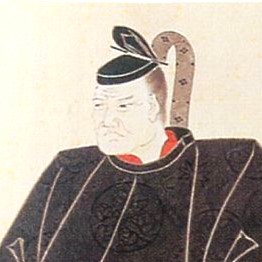
@Wikimedia Commons
Amid the afterlight under the lingering shadow of the Warring States Period, Tokugawa Ieyasu (1543-1616, 徳川家康), at the age of 70, took various initiatives to firmly establish a path to peace under the nation's rule. One of these measures was the construction of the sturdy Nagoya Castle, strategically positioned between Osaka and Edo. Leading the Owari Tokugawa family, the first among the Gosanke families, was Ieyasu's ninth son, Tokugawa Yoshinao (1601-1650, 徳川義直). Yoshinao succeeded his elder brother, Tadayoshi, who died at the young age of 28. Together with his young brother Yorinobu (1602-1671, 徳川頼宣), (the first lord of the Kii Tokugawa family) and Ii Naomasa (1561-1602, 井伊直政), one of Tokugawa Ieyasu’s trusted generals (the first lord of the Hikone domain), was trained at Sunpu Castle, Ieyasu's residence, during his young age. Upon his father’s passing, Yoshinao entered Nagoya Castle in 1616 and became a great lord who attempted to shift from military rule to civilian governance at 19.
World-Class Treasures of the Owari Tokugawa Family
Ieyasu's vast treasures and relics were divided among the first lords of the three domains (Tokugawa Yoshinao - Owari, Yorinobu - Kii, and Yorifusa (1603-1661, 徳川頼房) - Mito). Among them, Yoshinao, who was a great scholar, received many masterpieces and good books, and some of his valuable items are still in the Tokugawa Art Museum and the Hosa Bunko Library. The Picture Scrolls of The Tale of Genji (National Treasure), which has been read around the world for more than 1,000 years, 406 swords (including National Treasures and Important Cultural Properties), clothing and furnishings, and Ieyasu's collection of Suruga Books (2825 volumes) are just a few of the many items in the collection. The oldest surviving complete copy of The Tale of Genji, in 54 volumes and 23 books, is also a valuable item.

Opening paragraph: In what reign it was I cannot say, but there lived at court a certain lady, not of the highest rank, who was more favored than any other. / いずれの御時にか 女御更衣あまたさぶらひたまひけるなかに いとやむごとなき際にはあらぬが すぐれて時めきたまふ ありけり
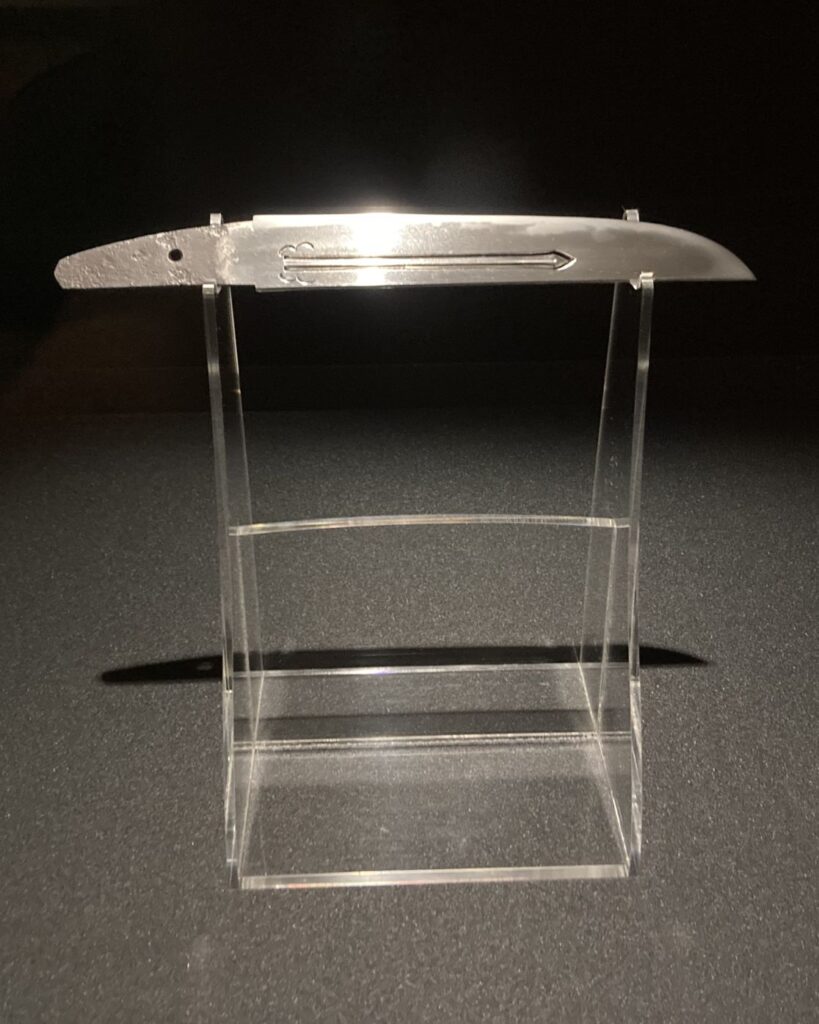
@The Tokugawa Art Museum
Yoshinao excelled in both literary and military arts, leaving behind a rich legacy of 220 books that were carefully reviewed for historical authenticity. These include The Gunsho Gokan (軍書合鑑), Military Book, which describes the knowledge and discipline necessary for actual battles, and The Jingi Hoten (神祇宝典), which describes the deities of venerable Shinto shrines and rituals along with color illustrations of sacred artifacts. The list is endless, including The Ruiju Nihonki (類聚日本記), a compilation of events from the age of the mythological emperors to the era of the 58th Emperor Koko (830-887, 光孝天皇), which later served as a reference for The Dai Nihonshi (大日本史), History of Great Japan, compiled by Tokugawa Mitsukuni (1628-1701, 徳川光圀) of Mito domain. Yoshinao studied Confucianism from Hayashi Razan (1583-1657, 林羅山), who had also been Ieyasu's teacher. On his way home from the summer campaign in Osaka, he purchased 143 volumes of the Analects in Kyoto. Yoshinao's passion for learning was passed on to the successive heads of the Owari Tokugawa family, culminating in the library having a remarkable collection of 50,000 books by the end of the Edo period, making one of Japan's leading federal lords's library in terms of quantity and quality. Today, this collection persists as the Hosa Bunko.
World's Largest Nagoya Noh Theater
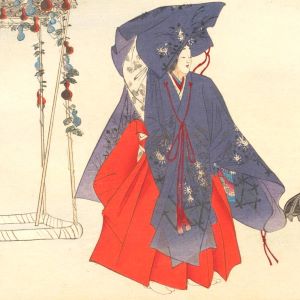
Noh, designated as an official art form by the Edo shogunate, held a significant place in samurai society as an essential art form. Among the 126 Noh masks passed down in the Owari Tokugawa family is one believed to be the world's finest, crafted by Zekan Yoshimitsu (1527-1616, 是閑吉満). The culture of Noh flourished, and Yoshinao enjoyed performing Noh as well. He, a skilled master of the Kozutsumi (small Japanese hand drum), and his wife, Haruhime (1603-1637, 春姫), an accomplished master of Koto, Japanese harp, likely shared in this artistic passion.
(source: 耕漁 [画]『能樂圖繪』前編 下,松木平吉)
Laid the Foundation for the Prosperity of Owari-Nagoya

The Owari domain had fertile lands nourished by the Kiso, Nagara, and Ibi Rivers, along with the vast and rich forest resources from the Kiso and Hida regions upstream. Recognizing the potential of his domain, Yoshinao dedicated himself to enacting laws and regulations, constructing the Kiso River embankment, expanding rice paddies and irrigation systems, and promoting the Seto pottery industry. Through these efforts, he laid the foundation for the prosperity of Owari Nagoya, which boasted an actual rice yield of approximately 1 million koku value. Additionally, Yoshinao ascended to the rank of Dainagon (chief councilor of state), the highest position among all feudal lords, possessing high family status within the Tokugawa regime. In the early Edo period (1603-1867), when the political system was still under development, Yoshinao frequently visited Edo Castle and continued to support the shogunate administration under the leadership of the third shogun, Tokugawa Iemitsu (1604-1651, 徳川家光). The young Yoshinao was supported by Hiraiwa Chikayoshi (1542-1611, 平岩親義), a trusted retainer of Ieyasu since their shared time as Ieyasu's hostages under the Imagawa clan, his brother-in-law Takekoshi Masanobu (1591-1645, 竹腰正信), and Naruse Masanari (1567-1625, 成瀬正成), whose bravery in the critical battle of Komaki and Nagakute for Ieyasu. Naruse Masanari later assumed the lord of Inuyama Castle, a key stronghold within the Kiso River distribution network. He built the wealth of the Owari domain by managing high-quality lumber, indispensable for the rapid construction of Nagoya Castle, Sunpu Castle, and various other castles nationwide.
Laid the Foundation of Geidokoro Nagoya, Nagoya of Art and Culture
Yoshinao had many cultural figures at his beck and call. The Kano school of painters, the Confucian scholar Hayashi Razan, the Tea Master Kobori Enshu (1579-1647, 小堀遠州), a man of Calligraphy Suminokura Soan (1571-1632, 角倉素案) for Saga books, the Hon'ami family for their sword polishing and appraisal, and many others. Along with these cultural figures, Yoshinao built the origin of Geidokoro Nagoya, Owari Nagoya of art and culture. Enjoy visiting Nagoya Castle, Tokugawa Art Museum, and other sites and experiencing a variety of arts and performances of Nagoya through commemorating the legacy of Tokugawa Yoshinao, the first lord of the Owari Domain.
Tokugawa Yoshinao Timeline
| Yoshinao | Ieyasu | Period | ||
| 1560 | Nobunaga defeated Imagawa Yoshimoto at the battle of Okehazama | - | 19 | Azuchi |
| 1561 | Ieyasu made an alliance with Nobunaga | - | 20 | |
| 1570 | Nobunaga & Ieyasu defeated the Asai and Asakura clans | - | 29 | |
| 1582 | Nobunaga was killed at Honnoji by Akechi Mitsuhide | - | 41 | |
| 1590 | Hideyoshi unified the nation | - | 49 | Momoyama |
| 1590 | Ieyasu moved to Edo according to Hideyoshi's order | - | 49 | |
| 1598 | Hideyoshi passed away | - | 57 | |
| 1600 | Tokugawa Ieyasu defeated Ishida Mitsunari at the battle of Sekigahara | - | 59 | |
| 1600 | Tokugawa Yoshinao was born | Age=1 | 59 | |
| 1602 | Yoshinao's brother, Tokugawa Yorinobu was born | - | - | |
| 1603 | Ieyasu established the Tokugawa Shogunate at Edo | - | 62 | Edo |
| 1605 | Tokugawa Hidetada became the 2nd Shogun of Tokugawa Shogunate | 6 | - | |
| 1607 | Yoshinao was changed his domain from Kofu to Kiyosu, then to Nagoya | 8 | ||
| 1611 | Ieyasu met Toyotomi Hideyoshi at Nijo Castle. Yoshinao joined the meeting. | 12 | ||
| 1612 | Ieyasu built Nagoya Castle | 13 | 71 | |
| 1614 | The Winter Siege of Osaka. The first battle of Yoshinao and Yorhinobu | 15 | 73 | |
| 1615 | Toyotomi's Osaka Castle burnt down to the ground at the Summer Siege of Osaka | 16 | 74 | |
| 1616 | Ieyasu passed away | 17 | 75 | |
| 1616 | Yoshinao entered Nagoya Castle | 17 | ||
| 1619 | Yoshinao established nagoya Toshogu Shrine | 20 | ||
| 1623 | Tokugawa Iemistu became the 3rd Shogun of Tokugawa Shogunate | 24 | ||
| 1632 | Hidetawa passed away | 33 | ||
| 1650 | Yoshinao passed away | 51 |
Recommendations to visit
Tokugawa Art Museum
- Access: 26 minitues from Nagoya Station Bus Terminal #10 to Tokugawaen Shindeki (徳川園新出来町) Bus Stop. Then 5 minute walk
Nagoya Castle
Access: 13 minitues from Nagoya Station. Take Nagoya City Subway, Meijo Line to Hisaya Odori (2 stops), then transfer to Meijo Line bound for Ozone. Get off the subway at the next "Nagoyajo Station (名古屋城)". 5 minutes walk from Exit 7.

